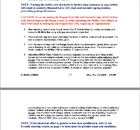amclaughlin200
Registered
So it’s free flowing at the surface after purging it? You have a very lightly tuned regulator… increased pressure at depth or obstructing the mouthpiece opening will prevent or stop the flow.
Nothing wrong with it unless you can’t stop the free flow with increased pressur
[QUOTE="happy-diver, post: 103927...lator-manuals/Hollis_Regulators.pdf
[/QUOTE]
MLess work of breathing means breathing muscles are working less, less energy spent, and a lower gas consumption. High WOB can lead to deficient ventilation, causing a CO2 build up, so depending on your depth, the density of the gas and your workload, you should be careful of artificially raising the WOB.
In general, lower WOB is
Less work of breathing means breathing muscles are working less, less energy spent, and a lower gas consumption. High WOB can lead to deficient ventilation, causing a CO2 build up, so depending on your depth, the density of the gas and your workload, you should be careful of artificially raising the WOB.
In general, lower WOB is better.
She is doing it right, you are doing it not so right.
Don't, she is doing it right.
It appears to be doing what it was designed to do, no issues.
"High Flow Setting -I think that it is working as it should. When the knob is out all the way and the venturi is on and you press the purge button it will let air out and will continue to do that until you put your finger/thumb on the mouthpiece opening to stop the venturi effect and the freeflow should stop. It is supposed to do that by design.
When you are diving, you should have the adjustment knob on full +, open all the way out, and venturi on. As long as the mouthpiece is in your mouth, adjustment knob should be all the way out and venturi on full on. The only time you turn the knob back is if there is air leak when you are breathing from the second stage. You turn the knob back just to stop the leak. When the regulator mouthpiece is out of your mouth, the knob should be turned in and venturi off.
• When diving deep or during other periods of heavy exertion, it is desirable to
make the 212 breathe as easy as possible. This setting should be used only when
necessary to avoid loss of air that may occur due to the 212’s extra sensitivity at
this setting.
• To adjust the 212 for minimum breathing resistance, rotate the adjustment knob
'counter clockwise' until a slight flow of air begins, then rotate the knob
'clockwise' until the flow stops.
• Frequently monitor your air supply when the 212 is adjusted for maximum flow."
At least you inspired me to fully read the manual. Hollis doesn't want you diving it fully open unless needed/specific conditions. Where is the idea coming from that you just dive full on no matter what? I'm not restricting my breathing by turning the knob down a bit. It's more comfortable because I don't like when the regulator feels like it's forcing air into my mouth. If it's your preference to dive with it completely open then I get that. But you said I was "wrong."




